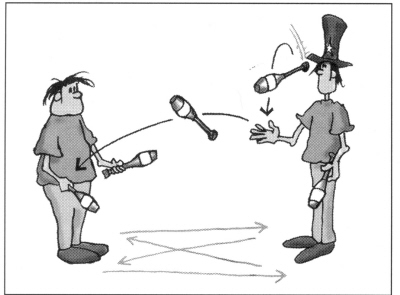|
Juggler's Workshop
Charlie
Dancey's Compendium of Club Juggling
In this issue we're reprinting, with the kind permission of the publisher, Butterfingers of Bath, England, selected entries from the brand new book Charlie Dancey's Compendium of Club Juggling (reviewed elsewhere in this issue). Items in bold are cross references to other entries in the book, though most referenced entries are not reprinted here. We're printing these entries in alphabetical order, which is how they appear in this encyclopedic book for easy following of the many cross references. -
Martin Frost
Every
throw in this
pattern is a pass. You throw diagonal Singles (that
is right
to right and left to left) to your partner and they throw tramline
Singles back. Five
Club One Count Here's
a Passing Pattern that is ideal for absolute beginners. It's a
two person pattern that uses five clubs and passes are made from both
right and left hands. The term One Count means that every throw
is a
pass. It's closely related to the much more advanced Seven
Club One Count. This pattern is just about the easiest One Count
that there is!
-Stand
facing your partner, you get three clubs and they have just two. You
begin with two clubs in your right hand.
A
map of the sequence of passes
in a Five Club One Count, only one juggler is making a
throw at any
Lead
with a diagonal pass from your right hand, to your partner's right hand,
this gets the pattern started.
As
the pass approaches they toss you a tramline [straight] pass back, which
triggers you to throw a left to left and so the chain reaction of passes
goes around the pattern.
The
Five Club One Count is, as readers of the Encyclopaedia of Ball
Juggling will realise immediately, a Domino Pattern!, so
named because it resembles a chain of falling dominoes. Each throw
'forces' the next as the receiving hand makes itself empty for the catch
- just as each toppling domino knocks over the next one. See
also Passing Patterns, Seven Club One Count.
The
Five Club One Count looks
pretty complex in
Ladder Notation but take note all those long holds that make it
so easy to juggle. Below,
for comparison is a Causal Diagram of the same pattern which
clearly reveals its amazing simplicity.
The
Causal Diagram is read from left to right. You juggle the bottom row
(passing right to right and left to left) partner juggles the top row
(passing right to left and vice versa) Five-O-Four Site
Swap Notation fiends need no more instruction, juggle 504 and
you have it. The rest of us might like a slightly more gentle and
informative introduction.
The
three throws used in the pattern are, as you would expect 5, 0
and 4. The 5's are crossing Triples, the 4's
are self Doubles, and the 0's are 'Gaps' (empty
hands).
The
Five-O-Four has a slightly curious rhythm, and the best way to
learn the pattern (unless
you can sight-read SiteSwap) is to start by juggling a Slow
Cascade of three clubs on Triples as a warmup.
Five-0-Four is an elegant pattern for three objects which looks particularly good with fire torches because it keeps everything well up in the air. You can arrive at the Five-0-Four by adding extra Doubles to a Slow Cascade, alternatively if it can be thought of as the pattern Five-Three-Four with one club missing.
The
Triples take so long to cross the pattern that your hands are actually
hanging around doing nothing for most of the time. In SiteSwap this
reads as: 5
2 2 5 2 2 5 2 2 5 2 2 ... The
2's represent the time that your hands
Now
you are ready to add the Doubles. Take two clubs in the right hand
and one in the left. Remember that every Double is a throw to the
same hand while every Triple crosses the pattern. Lead into the
pattern with
If
you are competent with Doubles and Triples you should be
able to master this pattern. Its main difficulty is that it goes against
the usual juggler's instinct to throw only
when you have to. In Five-O-Four you are throwing whenever
you can.
If you find the Five-O-Four too knacksome and tricky than you can always practise it with balls first. Just make sure that the 5's are thrown to about double the height of the 4's.
Once
it's solid you can polish up those fire torches and wait for nightfall! |




